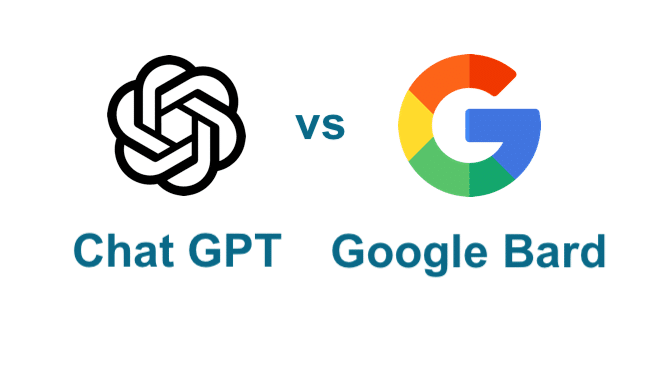In 2023, Google Bard and ChatGPT have become two of the most renowned AI chatbots. But which is a better option? What are the differences? At their fundamental levels, both chatbots use natural language processing, which means that users enter a prompt or query, and the chatbots generate a human-like response.
However, the significant difference boils down to the data sources and models they’ve been trained on.
- Google Bard employs Google’s Language Model for Dialogue Applications (LaMDA) and can provide responses based on real-time, current internet research.
- ChatGPT, on the other hand, employs its Generative Pre-training Transformer 3 (GPT-3) model (or GPT-4, depending on the version), which is trained on data from before late 2021.
But that’s not all; we’ll go into details in the course of this article, giving you the information you’ll need to decide which is a better pick between Google Bard and ChatGPT (Google Bard vs ChatGPT) and tell their differences.
Google Bard vs ChatGPT
We’ve all experienced the buzz surrounding ChatGPT in the months since OpenAI made it available to the public. You’re probably one of its 100 million users, as I am, who have used the AI chatbot to develop article content ideas, search for certain facts before 2021, send letters you’d rather not write, or get Google Sheets formulas you can’t figure out on my own. (Which happens rather frequently.)
While we may have mastered the art of writing prompts for the best results, it is painful to note that ChatGPT has a couple of limitations: for example, its training data were all written prior to September 2021, so it’s not exactly “in” with current news.
We’ve also had access to Bard, and with a couple of research to see how it compares to ChatGPT and the primary differnces between the two chatbots (Google Bard vs ChatGPT), here’s what we know.
What is ChatGPT?
ChatGPT is an AI-powered chatbot that answers questions in a conversational discussion using machine learning. On November 30, 2022, OpenAI launched ChatGPT. According to OpenAI CEO Sam Altman, ChatGPT achieved 1 million users in five days.
GPT stands for Generative Pre-trained Transformer, and it is used to discover patterns in data sequences. ChatGPT currently employs the GPT-3.5 language model, which has been trained using human-generated text from the internet. ChatGPT Plus, the premium version, now employs the improved GPT-4 model. It formulates responses to user questions using the AI language model.
What is Bard?
Google Bard is an AI-powered chatbot that leverages Google’s Language Model for Dialogue Applications (LaMDA) to replicate human interactions using natural language processing and machine learning. Through this large language model, Bard provides more detailed answers to questions than a typical Google search. LaMDA’s lighter and second version utilizes less computational resources, allowing it to scale for more people to use and provide feedback.
Like digital assistants such as Alexa and Siri, Bard’s main goal is to retrieve information in a simple answer rather than a search engine results page, but with links for users to gather more information. Bard also works as a personal assistant, assisting with activities such as trip planning, discovering existing reservations, and meal preparation. Bard searches using conversational or natural language inquiries rather than search engine terms.
Google Bard vs. ChatGPT: Features
Both tools are fairly simple, consisting mostly of an empty search box. They both allow you to access earlier chats and alter previous chats in order to regenerate responses.
However, there are a few minor differences in feature sets. Google Bard allows you to deliver voice prompts using your device’s microphone, which is convenient for a hands-free experience. It also has a quick “Google it” button that provides in-line links to continue your research outside of Bard.
Another exciting element of Bard is “drafts.” When you enter a prompt and begin a conversation with Bard, it will present you with various drafts or variations of responses. It’s a quick approach to narrow down your alternatives and focus in on what you want. It is also great how Bard shows past prompts. Click on “Bard activity,” and you’ll get a list of all your prompts, with the option to view details or delete from history. You can also disable Bard from saving your activities.
ChatGPT, on the other hand, collects conversation suggestions and shows them in the sidebar. This useful strategy encourages you to use ChatGPT in extended talks about specific themes. You can rename or delete these discussions, but you’ll have to scroll back to see the responses to individual requests, which can be inconvenient. ChatGPT does provide a dark mode, as well as the ability to clear all discussions, which is a welcome addition.
Google Bard vs. ChatGPT: Major Differences
#1. Google’s LaMDA(Language Model for Dialogue Application), Bard, is designed for dialogue, whereas OpenAI’s GPT is designed for text functions
Both models use a transformer architecture, a type of neural network that handles sequential input. GPT-3 and GPT-4, on the other hand, were trained on a vast dataset of text from the internet (containing novels, journals, and papers from the open internet), and LaMDA was trained on Infiniset, a dataset focusing on dialogue and conversations.
While GPT can understand and generate a wide range of text for a variety of purposes, LaMDA was specifically designed to have more natural and open-ended conversations with humans.
This means, LaMDA has been trained to recognize the purpose behind a user’s query as well as the nuance of context. To do this, the Google team organized high-level concepts and themes into hierarchical clusters, which were then utilized to inform the model’s response options.
Simply put, LaMDA’s responses are designed to be ultra-authentic, mimicking human speech so closely that it cannot be distinguished from a genuine human. It may also change context when the user changes the subject, just like you and I. However, it is a little over-zealous in its authenticity and claims to have feelings, which is unsettling.
Read Also: GMAIL LOGO: Does Gmail Have a New Logo?
ChatGPT was more forthcoming with responses. It is aware that it is a bot and does not attempt to persuade you otherwise. It will tell you the truth.
While LaMDA can converse more like a human (overconfidence and all), it probably won’t be able to summarize large chunks of text as well as GPT.
When it comes to natural language activities, GPT is the industry standard, powering various AI tools such as Jasper, Copy.ai, and Bing’s AI tools. It has been extensively trained on web content and is now mostly focused on generating text based on statistical trends. It operates as a chatbot as part of ChatGPT but can also serve as a summarizer, translator, and other textual tasks.
#2. ChatGPT can write a lot of text, but Bard can draw from the internet
Users will be able to ask Bard questions on a variety of topics, such as recipes, party planning advice, or historical events, much as they do now with ChatGPT.
The main difference is that Bard can get its answers from the internet, bringing in real-time data, which is tempting given that ChatGPT is still certain it’s 2021. Here’s an illustration: Bard was able to summarize and comment on the public and critical reception of a book published in 2023.
This is in stark contrast to ChatGPT’s broad knowledge. When you ask it the same question, it can only inform you that it doesn’t know the answer.
It means that when it comes to current events and research, Bard will (supposedly) provide more accurate and up-to-date information. It’s meant to be a more advanced personal assistant than ChatGPT, but a recent blunder has already jeopardized its trustworthiness.
ChatGPT, on the other hand, excels at textual functions such as writing articles or emails and brainstorming content marketing ideas. It’s a rudimentary text editor, but it’s far from flawless. It can be a little ambiguous and frequently provides generic responses (even when asked not to).
#3. Bard provides a superior user experience
In terms of user-friendliness, Bard is lightyears ahead. It not only looks better (with formatted language that is much easier to scan than ChatGPT’s chunky text), but you can also edit your questions after you ask them and view various responses that it prepares.
#4. Bard will be a simplified version of Google Search, whereas ChatGPT will be a Bing product
Bard’s capacity to synthesize knowledge into an understandable style, regardless of how complex a topic, suggests that it could eventually improve the way people seek for information.
Google Search has already revealed that Bard will be included. That is, the AI will simplify complex topics and offer facts in easily digestible formats, allowing you to get insights into opposing viewpoints. (This is especially important for questions with no single proper response.)
Microsoft, on the other hand, has already integrated parts of OpenAI’s adjusted GPT-4 model into Bing, providing users with a ChatGPT-like search experience. However, it is still quite limited, and users must join a waiting list to access the full experience.
So, what should future Bard users be aware of?
- Bard has a more current knowledge base because it uses data from the internet instead of ChatGPT, which is trained on data up to 2021.
- Bard will be included into Google’s search engine to help consumers find information on complex issues more easily.
- ChatGPT primarily focuses on text functions, whereas Bard intends to improve research and comprehension in education, business, and other disciplines.
- Bard is supposed to deliver more precise information, whereas ChatGPT requires careful prodding to produce more detailed responses.
| Creators | OpenAI | |
| Language model | Depending on the version, a particularly modified version of OpenAI’s Generative Pre-training Transformer 3 (GPT-3) or Generative Pre-training Transformer 4 (GPT-4). | Language Model for Dialogue Applications (LaMDA) by Google |
| Data sources | ChatGPT was trained on a vast text dataset that included Common Crawl, Wikipedia, books, articles, documents, and content collected from the open internet—but its sources expire in 2021, limiting access to the most recent world events and research. | Bard was trained on Infiniset, a data set that includes Common Crawl, Wikipedia, documents, and web chats and dialogues; Bard is said to scan the web in real-time for the most recent responses to inquiries and research. |
| Pricing | ChatGPT is free for all users; ChatGPT Plus costs $20 per month and includes peak-time access, faster response times, priority access to new features, and usage of GPT-4. | Bard is free to users who have access |
| Conversation Retention | According to OpenAI, ChatGPT can recall what was stated in earlier chats. However, there are two caveats: the bot can only remember up to 3,000 words (anything beyond that isn’t saved), and it doesn’t use previous conversations to form responsesz. | Google argues that Bard’s ability to retain context is “purposefully limited for the time being,” but will improve over time. |
Is Google Bard and ChatGPT yet available?
ChatGPT was the first and, in many respects, remains the best alternative for individuals interested in experimenting with AI-generated text. First and foremost, it is freely available for anyone to test out. ChatGPT’s ubiquitous accessibility from the start has contributed to its success.
Google Bard, on the other hand, is only available to users in the United States and the United Kingdom. There is a waitlist to join, but there are a few quick ways to get to the top of it. If you’re a Google One member, you’ll have access as soon as you sign up. Members of the Pixel Superfan group are no exception. Everyone else may still be waiting in line as Google adds more spots.
Which is better, Bard vs. ChatGPT?
When comparing the two, keep in mind that ChatGPT and Google Bard were designed with subtle differences in mind: ChatGPT is better at generating and summarizing text, whereas Google Bard is better at surfacing relevant information to questions. However, both tools are still in their early stages, and only time will tell which outperforms the other.
Alternatives to Generative AI
Other AI content generators are available. ChatSonic, Jasper, Open Assistant, and Wordtune are among the startups working on their own ideas. Baidu, China’s search engine, employs AI in an application called Ernie Bot.
The future of AI in marketing continues to grow and adapt at the same rate as it began, with additional applications beyond content generation including customer support, email optimization, product suggestions, and social media posts.
Related Articles
- WRITERS GRANTS: Top 50 For Poets, Fiction & Nonfiction Writers In 2023 (UPDATED!)
- WHY DOES CHATGPT GIVE NETWORK ERRORS? Simple, Easy Fixes!!!
- Chat GPT: Will ChatGPT Replace Google? The Model Analysis
- WHY IS CHATGPT AT CAPACITY? How to Fix it Now
- ChatGPT: What the Future Holds & All You Should Know






